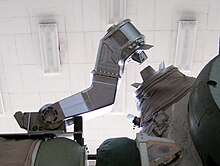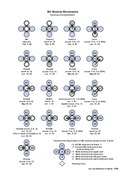Lappa

Lappa (ros. Ляппа) – robotyczne ramię używane przy konstrukcji stacji Mir do przemieszczania modułów stacji Mir z portu osiowego, do którego cumowały, na porty obwodowe. Elementy styku były na stałe zamontowane na obwodowych portach cumowniczych. Ramię łączyło się gniazdem, znajdującym się na węźle cumowniczym, niedaleko przejściowej sekcji modułu bazowego[1].
Moduły Kwant-2, Kristałł, Spiektr i Priroda wyposażone były w takie ramiona. Po zadokowaniu do modułu bazowego mechanizm zatrzaskiwał się, blokując pozycję modułu na głównym węźle cumowniczym. Cięgło głównego węzła cofało się, a mechanizm ramienia unosił i obracał moduł o 90°, umożliwiając jego cumowanie na jednym z węzłów obwodowych[2][3].
Galeria
Ramię Lappa w muzeum zakładowycm RKK Energia
Diagram relokacji modułu Kwant-2.
Zobacz też
Przypisy
- ↑ NASA "STS-79" report (ang.). s. 13. [dostęp 2016-02-25].
- ↑ David Harland: The Story of Space Station Mir. New York: Springer-Verlag New York Inc, 30 listopada 2004. ISBN 978-0-387-23011-5. (ang.)
- ↑ David S. F. Portree: Mir Hardware Heritage. NASA, March 1995. (ang.)
Media użyte na tej stronie
Russia's Mir space station is backdropped over the blue and white planet Earth in this medium range photograph recorded during the final fly-around of the members of the fleet of NASA's shuttles. Seven crew members, including Andrew S.W. Thomas, were aboard the Space Shuttle Discovery when the photo was taken; and two of his former cosmonaut crewmates remained aboard Mir. Thomas ended up spending 141 days in space on this journey, including time aboard Space Shuttles Endeavour and Discovery, which transported him to and from Mir.
Figure 3-11. Repositioning Kvant module using Lyappa arm.
Lyappa arm (figure 3-10) attached to a fixture in the Mir base block’s multiport docking node and pivoted Kvant 2 from the front longitudinal port to its assigned lateral port (figure 3-11). Kristall, Priroda, and Spektr also carry the Lyappa arm.Autor: Jonathan McDowell, Licencja: CC BY-SA 3.0
"Kvant-2 docking manipulator detail" located at the Gagarin Cosmonaut Training Center's Mir training hall in Star City, Russia.
Autor: Leebrandoncremer, Licencja: CC BY-SA 3.0
This PDF displays the movements of the internal Conus docking cones within the Mir core module's forward docking hub over the lifetime of the station. Most Conus movements were made by cosmonauts during internal EVAs lasting approximately 20 minutes, as the Conus placement required removing one of four outer hatches exposing the pressurised hub to the vacuum of space.
Also shown are the documented module additions and movements around the forward docking hub, as well as major exterior additions such as Strela cranes and trusses such as Sofora, Rapana and Strombus. Each phase displayed in a line drawing view with notes. Solar array deployments and relocations are also shown.
Autor: Jonathan McDowell, Licencja: CC BY-SA 3.0
"Side module manipulator arm (NOT called "Ljappa"! That name is apparently a myth.)" located at the RKK Energiya museum in Korolyov, Moscow Oblast, Russia.
Survey view of the Mir space station taken by the crew of the STS-79 orbiter Atlantis while docked with the station. Lyappa arm and attach fixture on central node (023-39). Image ID: STS079-814-031










